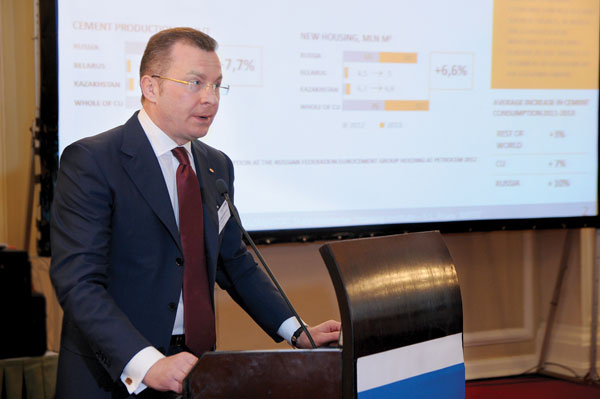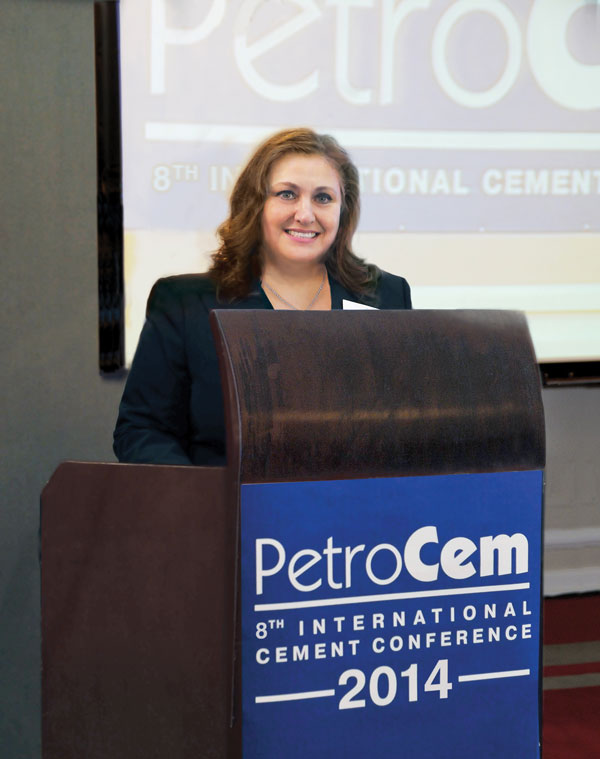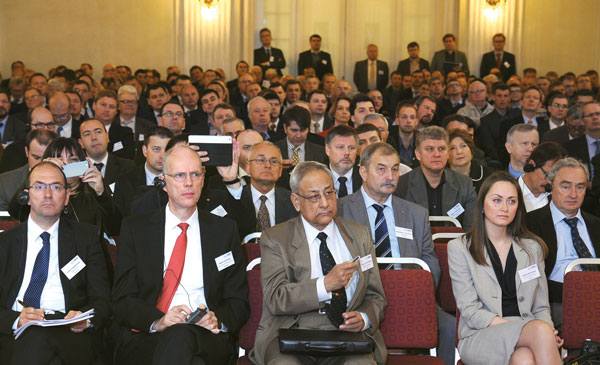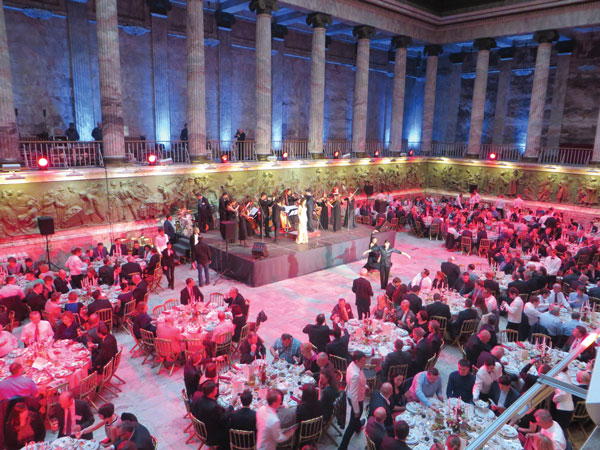PetroCem 2014
Cement producers from Russia, CIS countries and eastern Europe gathered at the Astoria Hotel in St Petersburg, Russia, for the Eighth PetroCem international cement conference and exhibition on 28-29 April. Taking place every two years, this event saw 500 delegates participate in an extensive presentation programme to explore the challenges and successes of the regional industry, and celebrate in style at some of St Petersburg’s most impressive city venues.

Mr Mikhail Skorokhod, chairman of the board of NPO “Sojuzcement” and president of Eurocement, reviews
the strong performance of the Russian cement industry and new era of investment but cautions over
the risk of overcapacity in the future.
Addressing delegates on the first day of the meeting, Mikhail Skorokhod, chairman of the Board of NPO “Sojuzcement” and president of Eurocement Group, the leading cement producer in Russia, heralded the emergence of a modern and more efficient cement industry in the region, where dry-process cement plants utilising state-of-the-art technologies are now becoming the norm as new capacity is installed and old wet-process kilns are retired.
In the countries that form the Customs Union (CU), namely Russia, Kazakhstan and Belarus, dry-process cement plants currently account for 38 per cent of installed capacity (Belarus – 57 per cent, Kazakhstan – 63 per cent), although in Russia the figure is only 33 per cent, presenting a key investment challenge for the country going forward. But the situation is changing and the industry is modernising rapidly.
Indeed, according to Russian analysts CMPro 8.5Mta of new capacity was brought online in 2013, with another 6.4Mta expected in 2014 and a further 10.6Mta in 2015. Nevertheless, while this volume of capacity seems high, it is noted that between 1988 and 2007 (perestroika) there were no new capacity additions, and many of the old facilities continue to use inefficient wet- and old dry-process kilns.
Sustained market growth
Speaking about the market, Mr Skorokhod said that cement consumption in the CU countries climbed by eight per cent to 81Mt in 2013, of which Russia alone accounted for some 69.7Mt. Looking ahead, he is confident that the Russian market will enjoy sustained growth, quoting a recent study by McKinsey, which sees demand rising to 103Mt by 2020 (implying a CAGR of 5.7 per cent). However, he sounded a note of caution, arguing that it was possible supply could potentially reach 107Mta over the same period, potentially tipping the industry into unwelcome oversupply.

Mila German, PetroCem conference organiser and
general manager of Journal Cement and its
Applications, welcomes delegates to PetroCem 2014
Next to take the podium and widen the discussion was Yassine Touahri of Exane BNP Paribas, who presented an incisive world industry overview. Commenting on the recently announced Lafarge-Holcim merger, he argued that the deal would create “an uncontested global leader” and is viewed favourably as a “strong strategic response to increasingly ambitious emerging market producers and fragmentation in many profitable emerging countries”. Indeed, it can be noted that by virtue of its 10 per cent stake in Holcim, Eurocement Group will also participate in this development. From a market perspective, Mr Touahri concluded that better mature market demand is expected in 2014, while emerging market volumes will slow down in Brazil, India and even Russia.
Turning to a more regional perspective, Amanulla Ibragimov of AK Uzstroymateriali provided an optimistic appraisal of the Uzbekistan cement market, where annual demand rose by 16.6 per cent in 2013. By 2020, it is envisaged that domestic capacity will increase to 12Mta with a number of new projects in progress, including new facilities at Sherabad (1.5Mta), Dzharkurgan (0.45Mta) and Bekabad (0.85Mta). So far in 2014, OAO Almalyk MMC has commissioned a new grey/white cement plant at Jizzakh, built by Turkish company Dal Teknik Makina.
Tackling carbon emissions
Speaking from a European cement industry perspective, Koen Coppenholle, chief executive of Cembureau, the European cement association, highlighted the importance of the cement industry to the region’s economy, and noted the need to remain competitive while retaining the ‘carbon leakage’ status under the European Emissions Trading System. Reducing carbon emissions remains a priority for the industry. Discussing the long-term outlook, he observed that by employing carbon capture and storage (CCS) technology, Europe could reduce CO2 emissions by 80 per cent by 2050, or by 32 per cent without CCS.
Alternative fuels, which now represent one third of all fuels used in the European cement industry, have the potential to be increased to 60 per cent by 2050, while the average clinker-to-cement ratio should reach 70 per cent by this time.
In spite of the obvious carbon intensity of cement during manufacture, Mr Coppenholle argued that when assessed over the lifecycle of the product, cement has a valuable role to play in creating a low-carbon society: cement products and concrete are ideal materials for creating an energy-efficient, resilient and durable built environment.
Technological advances
Martin Schneider, CEO of VDZ, the German cement association, gave a thought-provoking presentation on the future of cement manufacturing technology and advances that new technologies will bring to performance. Energy efficiency has been greatly enhanced by waste heat recovery, particularly in Asia, but the application in Europe is constrained due to the fact that a high percentage of waste heat is typically used for drying raw materials, slag and fuel. Much of the remaining waste heat is non-recoverable at <100°C. Clinker cooler technology has improved dramatically over the last half century and now fourth-generation coolers can achieve 80 per cent efficiency, compared to just 50 per cent with the rotary cooler of the 1950s. Dr Schneider argued that grinding still offers potential for further efficiency improvements as there is a huge potential to manufacture better drives while breakthrough technology in comminution is not impossible. Similarly, new cements, such as Belite and Celitement, offer potential opportunities for CO2 reduction, though this area is still largely experimental.
Projects showcased
A number of presentations focussed on examples of capacity expansion projects or new plant construction, with all major turnkey equipment suppliers represented. A Talnikov of YuUGPK, Russia, described the successful commissioning of his company’s new integrated greenfield plant in the south Urals, equipped with two 3000tpd kilns built by KHD Humboldt Wedag (Germany).
Sergey Rogachev of OAO Seryakovcement, Russia, gave a joint presentation with Palle Grydgaard, FLSmidth A/S (Denmark), describing the wet-to-dry upgrade of this plant. In a state-of-the-art solution for dry-process plant design all the raw mix was prepared in one of two stock piles and fed direct to the kiln. The nature of the raw materials, which are high in moisture content, made it possible to eliminate the need for a raw mill and homogenisation silo, resulting in significant cost savings. Operationally, the plant manager must now manage the raw material storage more strictly, using one for kiln feed while the other is filled.

PetroCem attracted an international cement sector audience
Technical papers covering grinding advances were expertly delivered by a range of suppliers: Ronald Burkhardt (ThyssenKrupp Industrial Solutions) described the advantages of the Quadropol RD vertical mill with drive rollers, while Roland Martini of Gebr Pfeiffer presented a case study of the new high-capacity MVR 5600 C-4 mill at the Balaji Plant in India.
Uwe Karsunke (Christian Pfeiffer) presented the benefits of ball mill technologies, while Yu Volshin of Fives FCB remained with this technology to describe an open-to-closed circuit modernisation project and the installation of third-generation separators. The session was completed by Marco Goisis of Italcementi providing his view on the fundamentals of grinding technology from a user’s perspective.
Other themes covered by the programme included bulk material handling (IBAU Hamburg, Aumund and Beumer), refractories (Calderys and Höganäs Bjuf) and various approaches to optimisation. Patrick Logerot of Group SNEF described the options for successful integration of modern software systems and infrastructure into cement plants, while Petra Muehlen of Process Technology Solution GmbH, introduced the new SpectraFlow online NIR spectroscopy analyser for raw meal optimisation.
Exhibition
The extensive presentation programme was complemented by a large 50-stand exhibition that was held alongside the main conference proceedings, providing delegates with a convenient forum in which to learn about the latest technological developments and place orders for new plants. The consensus for many of the international suppliers was that Russia was sometimes a difficult market to break into but a large and growing one with great future potential.

Gala Dinner at the Mikhailovsky Palace: an opportunity to wind down in style
Evening receptions and dinners provided essential downtime and the opportunity to meet other delegates, colleagues and friends. Outside of the conference proceedings, the clear highlight of the event was the spectacular Gala Dinner held at the remarkable Mikhailovsky Palace. Delegates entered an immense marble hall for an impressive feast of Russian delicacies and spectacular entertainment, providing a perfect conclusion to another first-class industry event.
Article first published in International Cement Review, July 2014.

